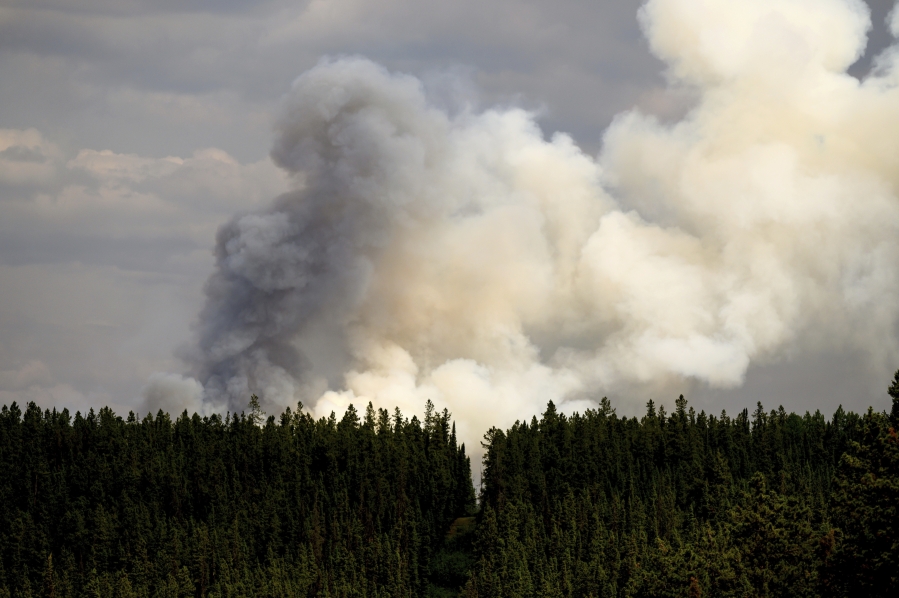WENATCHEE — When is wildfire smoke harmful to my health? What are its effects? Can I wear a surgical mask to protect myself?
These are questions often asked in the Wenatchee Valley and in a growing number of U.S. states each year during wildfire season.
Below are explanations and other tips to help the public this summer and fall.
What is wildfire smoke?
Wildfire smoke is made up of hundreds of types of air pollutants, according to the state Department of Ecology. The most concerning are “fine particles.” These particles are tiny — about 2.5 microns or less in size — and made of partially burned wood. In comparison, the width of a human hair is around 70 microns.
What health problems can smoke cause?
Wildfire smoke can cause several health problems. Inhaling wildfire smoke for people with pre-existing conditions like lung or heart disease can be especially harmful, according to the state Department of Health.
Healthy people can also have symptoms or health problems including:
- Eye, nose, and throat irritation (burning eyes and runny nose)
- Fatigue
- Headache and coughing
- Wheezing and shortness of breath
- Mental health concerns and psychological stress
People with heart and lung diseases could see their conditions worsen and see symptoms like asthma attacks, chest pain or irregular heartbeat.
If experiencing severe symptoms while in wildfire smoke, like chest pain or difficulty breathing, people should seek medical attention.
What can I do to protect myself from wildfire smoke?
The most effective way to protect yourself from wildfire smoke is to stay inside, limit your time outside and reduce physical activity, according to the DOH.
People indoors should close all windows and doors and filter the indoor air through an HIVAC system or a HEPA portable air cleaner.
Don’t add to indoor pollution. When it’s smoky, avoid burning candles or using sprays or air fresheners along with broiling or frying foods. Avoid smoking and your use of gas or propane stoves or ovens, for example.
What kind of masks can I wear?
If you must be outside, consider wearing an N95 mask. These masks are available at hardware stores and pharmacies. The mask must be certified by the National Institute of Occupational Safety and Health.
A one-strap paper mask or a surgical mask — the kind commonly seen during the COVID-19 pandemic — will not protect your lungs from wildfire smoke.
The mask should fit over your nose and under the chin, sealing tightly around your face. It will be difficult to breathe through a mask, so people should take breaks if they work outside.
If feeling dizzy or sick, go to a less smoky area, take off the mask and get medical help if you do not feel better.
Who is at an increased risk in wildfire smoke?
The DOH identifies these people has having an increased risk of severe health impacts due to wildfire smoke:
- People with lung diseases, such as asthma, or respiratory infections like pneumonia or COVID-19, or people with existing heart problems like coronary artery disease.
- People with a prior history of heart attack or stroke.
- People with diabetes because they are more likely to have an undiagnosed cardiovascular disease.
- People 18 and younger because their lungs and airways are still developing, and they breathe more air per pound of body weight than adults.
- People older than 65 because they are more likely to have unrecognized heart or lung diseases.
- Pregnant people because both the pregnant person and fetus are at increased risk of health effects.
- People who smoke because they are more likely to already have lower lung function and lung diseases.
- Outdoor workers because they often spend more time outside and are exposed to smoke longer.
- People of color and tribal and indigenous people because of institutional and structural discrimination that often put these populations in challenging life circumstances and unhealthy environments.
- People with low income because they are more likely to have higher exposures and are less likely to have access to healthcare or to be able to afford interventions to reduce exposure.
How is air quality measured?
Air quality, or how free the air is of pollutants, is measured via the Air Quality Index (AQI). AQI runs from 0 to 500, with the higher value representing a greater level of air pollution.
One of the pollutants AQI measures is PM2.5, so particulate matter that is generally 2.5 micrometers, like the particles in wildfire smoke.
An AQI from 0 to 50 is considered good, where the air pollution poses little to no risk. After 50, air quality worsens from “moderate” to “hazardous.”
Find more information about each of the categories here. And find out about your area’s AQI here.



